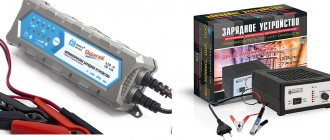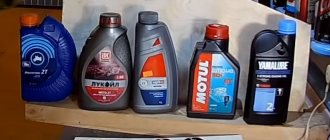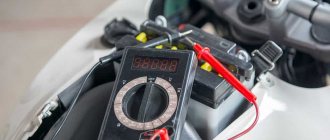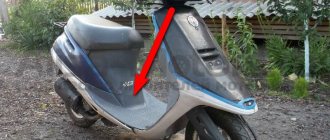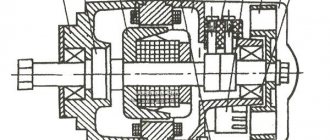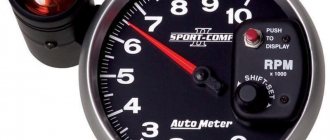Types of motorcycle batteries
If a few decades ago only acid batteries for motorcycles were on sale, today you can choose dry gel varieties of batteries that are distinguished by their quality and stability of operation, and their service life exceeds 5 years, during which the battery retains all its performance characteristics.
The most common types of motorcycle batteries today are:
- Acidic.
- Gel.
- Absorbent Glass Mat.
Acid modifications are the simplest designs that have lead plates filled with electrolyte.
During the operation of such batteries, it is necessary to constantly check the fluid level, if necessary, adding acid or distilled water to the jars. Motorcycle lead-acid batteries are made using numerous plates, which make it possible to obtain a reliable current, and the service life of such a battery can reach 5 years. Gel options are the latest development, which allows for smooth capacity and starting current characteristics, which ensures that the motorcycle engine starts even in severe frost. One of the features of AGM batteries is their long service life, which can exceed 10 years. Instead of electrolyte, such batteries use a special gel and insulating pads of lead fiberglass plates.
Absorbent Glass Mat (AGM) devices have a higher cost compared to their acidic counterparts. However, they are more reliable and have better electrical characteristics. In AGM batteries, a special material is impregnated with electrolyte, which is located between the electrode plates. As a result, there is no need to add electrolyte solution, since it does not boil away.
AGM batteries are characterized by higher frost resistance, which is important for residents of the northern regions of the country. In addition, it is worth noting two more advantages of this type of battery:
- high resistance to strong discharge;
- high starting current.
These batteries can be used for 5-10 years. However, they also have disadvantages, which include high sensitivity to voltage changes in the on-board electrical network and the need to purchase a high-quality charger.
Charging the battery and checking it
You need to check the charge of a battery you are purchasing (and subsequently, periodically of an already purchased one), since its service life and capacity retention depend on this indicator. You can use a voltmeter or multimeter to check the voltage.
The resulting battery voltage indicator must be greater than the nominal value. If the standard rating is 12 V, then the norm for it will be a voltage of 12.8 V. If this figure is less than 12 V, then a deep discharge occurs. If the voltage is less than 12.5 V, the battery is half discharged. When the generator and relay regulator are operating, the voltage should be 13.6 V.
Popular gel varieties
If initially classic acid batteries were the most popular on the market, today most motorcyclists choose gel batteries, which are reliable and easy to use.
Such a battery does not freeze even at temperatures of minus 30-40 degrees, it does not require any complex maintenance, including the need to constantly add electrolyte and monitor its level. Some modifications of gel batteries even imply the possibility of replacing the case, which can significantly reduce the cost of operating a motorcycle. If the motorcycle and battery are used correctly, such a battery will last for a long time, fully maintaining its performance characteristics.
We recommend: Types of batteries and their differences from each other
The structure of the electrolyte in AGM batteries allows the plates to retain their charge for a long time, and subsequent recharging does not present any difficulty.
On average, such a battery can withstand about 800 charging cycles, without causing any problems during the operation of the motorcycle, guaranteeing reliable starting of the engine.
Precautions when working with batteries
Batteries constantly produce explosive hydrogen, especially while charging. To avoid the potential risk of fire when working near a battery, the following guidelines should be followed:
Do not smoke near batteries.
Keep sparks, short circuits, or other sources of ignition away from the battery.
When disconnecting/connecting current-carrying cables, be sure to first turn off the consumers, turn off the ignition, and turn the key to the off position.
Ensure proper ventilation of the battery charging area.
The charger must be turned off in the following cases: a) when connected to a battery; b) when disconnected from the battery.
The ground wire (-) must be disconnected from the battery first and connected last.
Main characteristics of the battery
Gel batteries for motorcycles have a number of parameters that are typical exclusively for batteries from two-wheeled vehicles. These main characteristics include:
- Compact dimensions. Unlike car batteries, such gel-based batteries must be compact in size, which allows them to be installed in a small compartment near the engine or under the saddle. At the same time, compact dimensions must be combined with the necessary technical characteristics, which will be sufficient to start the engine.
- Connection terminal type. When choosing a particular battery for a bike, you need to remember that motorcycle batteries can have five different connection terminal configurations. Some manufacturers of motorcycles have smaller diameter connection terminals, which forces the use of special batteries. Finding a universal battery for all motorcycles can be problematic.
- Capacity indicators. This indicator determines the longevity of the battery, as well as the total amount of charge that is stored in the battery until it is completely discharged. When choosing a battery model, you need to pay attention to its capacity indicators, which must correspond to the data in the technical documentation for a particular motorcycle.
The correct choice of battery will guarantee a reliable start of the motorcycle engine, while the biker will be spared any difficulties with the operation of two-wheeled equipment. A properly selected battery will retain its charge for a long time, providing a high starting current.
What brands should you pay attention to?
Which manufacturers should you give preference to? Among the companies you can trust are the following brands:
- Exide.
- Banner.
- Varta.
- Bosch.
This is only a small part of the motorcycle batteries that can be found on the market. In addition, many companies that produce car batteries also have batteries for motorcycles in their product range.
Battery Features
Most modifications of motorcycle batteries are designed for a starting current of 12 Volts.
It is at this voltage that the engine and all attachments receive the necessary charge that is required to start the power unit. One of the features of using motorcycle batteries is that the battery drains quickly. This is explained by the fact that when the equipment is idle, the alarm system, clock, controller and various internal combustion engine systems continue to work, which leads to a load on the battery and its rapid discharge. That is why it is recommended in winter, when equipment is idle, to remove the battery and recharge it at home.
Why do batteries differ in size?
The dimensions of the battery depend on the number and size of lead plates. This, in turn, determines the battery capacity (Ah) and the power output. Sometimes batteries with the same capacity also have different sizes, this is due to different standards of motorcycle manufacturers.
How tight should the battery terminal bolts be?
The bolts on the battery terminals should be tightened as securely as possible, but without fanaticism. Since weak terminals can lead to problems with starting the engine, oxidation of the terminals, burning and melting of contacts, sparking (and, as a result, an explosion of the battery).
What is battery acid and is it caustic?
As we already wrote above, battery acid (electrolyte) is nothing more than dilute sulfuric acid. It is very dangerous and requires very careful handling using protective equipment, such as special gloves, an apron and safety glasses! Avoid contact with skin, eyes and clothing!
Proper Maintenance
The trouble-free operation of a motorcycle battery will largely depend on the quality of service provided to the battery.
In each specific case, depending on the type and model of the battery, they will require appropriate maintenance from the motorcyclist, including regular recharging and proper storage of the battery. In the simplest acid batteries, the case should be washed once a year, for which the electrolyte is drained, distillate is added and the case is cleaned of any existing contaminants. You will also need to regularly clean the terminals, for which you use fine-grain sandpaper. This cleaning of the terminals improves contact, preventing oxidation of problem areas.
You can check the charge of a motorcycle battery using a multimeter. Such measurements are carried out with the engine not running, as well as with the engine running, which makes it possible to determine the presence of leakage current and the correct functioning of the generator.
Most fans of two-wheeled transport put their motorcycles in the garage for the winter and remove the battery. It is necessary not only to remove the battery from the motorcycle, but also to recharge the battery immediately before the start of the motorcycle season, for which appropriate rectifiers are used. It is recommended to store the battery at room temperature, since in the cold in the garage the electrolyte and gel can freeze, which subsequently leads to a rapid discharge of the battery.
We recommend: Starting and traction battery for electric boat motor
To understand batteries, you first have to dive into the seething vat of everything on the market: longer, faster, conqueror of glacial peaks, panacea for global warming. That's what we'll do. All batteries are 12 volt, all have 9 ampere hours, all fit the same model of motorcycle, but they are all different. "PARTS-UNLIMITED" offers traditional batteries. The tradition of pouring acid onto lead plates dates back 150 years. It's cheap, it cost me 40 bucks and another 5 for the sulfuric acid. It turned out to be 3153 grams. For $15 on top you can get an AGM battery. It's basically the same, it's just that the acid is absorbed into the porous sheets of fiberglass that are placed between the electrodes. So you can send batteries already refilled without becoming a postal terrorist. You can also fall without having to douse your crotch with sulfuric acid, all thanks to the fiberglass sponge. 2960 grams. For 130 bucks, Bikemaster will add silica to the battery so that the acid becomes a gel. So nothing leaks from the gel batteries either, although they don’t wear fleeced glass wool panties like AGMs. In hot weather it seems to be cooler, but it is a little heavier, 3025 grams. And finally, the lithium battery. You can get it for $150. Shoray is the only one who skipped all his lead-acid chemistry classes. The lithium iron phosphate battery is five times lighter, at just 609 grams, and half the size. And while some can be laid on their sides, Lithium is the only one that can be turned over. Who needs it? First of all, let's measure the voltage drop. When the starter draws current, the battery voltage drops. And, as we all know, if you fall, everything is fine, it happens. It just has to fall in moderation, because if it drops completely, there may not be enough voltage to start the engine. Even though these batteries couldn’t be any newer, I will negate the difference in production dates and charge everything to full with the same charge. Usually lithium batteries are charged with special chargers, because the high voltage at the desulfation stage of a lead-acid battery can burn the lithium battery, but I found this charger - “Junior 800”. It charges lead-acid, AGM, gel and lithium batteries. Hmm, charging is the same, one less problem. To remove the surface charge from each battery, I connect a light bulb, then pass current through several resistors and read the voltage after fifteen seconds of load. Next, to measure the cold voltage, I freeze the batteries, because... Canada. An ordinary battery sank the most - 11.22 volts when warm and 10.43 when cold, this is not surprising: in order for the electrode plates to stand straight, they must be strong enough; they cannot be made of pure lead, it is too soft. Lead needs to be mixed with something, and the alloy is less effective. The AGM battery has better results: warm - 11.4, cold - 10.58. After all, his electrodes are wrapped in fiberglass, which protects them from the cold and also supports their structure, so the plates can be made from almost pure and so effective lead. The result of a gel battery at room temperature is even better, but in the cold it’s a little worse. Most likely because the gel thickens when cooled and its internal resistance increases. But the lithium battery, well, nothing for its size, showed 11.29 in the heat and gave only 9.75 in the cold. But you need to know how to handle cold lithium. Firstly, he is like a bear; he hibernates in winter. He definitely needs to be woken up. Before turning the starter, turn on the headlight for 30 seconds. And secondly, never charge a lithium battery in the cold. At temperatures below zero, the ions, instead of penetrating the anode, stick to it, forming dendrites, and dendrites are spiny, they can break through the membrane to the cathode and boom. The short circuit is small, but the flame is large. Oh, damn it, it's a damn thing. In general, the ability to deliver current without voltage sag is called inrush current. When cold - cold cranking current, or CCA. Well, it’s clear that the starting current is directly proportional to the price tag. We did not adjust the tests to industry standards, because they give different loads depending on the declared starting current of each battery, which would not correspond to our tasks in everyday life. So while our numbers don't match the CCA, they are pretty consistent with how each battery will cope with cranking the starter. Next, let's check the recharging speed. These hundred-watt light bulbs connected to twelve-volt batteries draw approximately 8 point 3 amperes. Let's run them for 15 minutes, so they'll draw about two point amp hours or so from each 9 amp battery. But the most amazing thing here is that school physics was at least useful for something. It's an electric octopus - dangerous. Do not repeat at home. The charger itself will tell you how long it will take for 2 and a penny ampere-hour to return to the batteries. In the meantime, we wait, I’ll tell you why I discharged the batteries to only 25% of their full charge. The fact is that it would be dishonest to discharge the cheapest battery deeper. The lead plates in lead-acid batteries are sulfated. With significant discharge, crystals form, they stick and the battery capacity drops forever. Ah-ah-ah. Absorbed electrolyte and gel batteries are less susceptible to this phenomenon, although it is still best to keep them charged. And lithium ones, thanks to phosphates, have no mood swings at all. You forget it for 8 months, charge it again, forget it again, it doesn’t move. Yeah, a traditional battery recharges in 125 minutes, AGM a little faster, in 118, gel even faster, in 112, and lithium opa. Not impressed. Our charging is smart, it supplies more or less depending on how it evaluates the battery itself. Lithium is famous for its ability to digest anything. It is precisely because of fast charging that Elon jerks off to lithium, but... Not in our case. We leave the fully charged batteries on the shelf and go think about the meaning of life. Discharge during storage. 2 months. Yes, that's right, I left the applicants for 60 days, essentially leaving them to die. Vanity. With a fatal outcome. So how “dead” are they? A regular battery lost 0.23 volts, this corresponds to a 20% discharge, which is completely normal for a lead acid battery. The AGM discharged at 0.35 volts, weakly. The gel one lost 0 point 25 hundredths, and the lithium one lost about 7 hundredths of a volt! Yes, we compare apples with pears, with tomatoes and with cucumbers, because each has its own open circuit voltage and its own discharge scale, but it is still obvious that lithium holds up better than everyone else. I would put the rest on charging in storage mode for the winter. As a result, we can confirm a well-known phenomenon: lithium discharges amazingly slowly throughout almost the entire decay. Gel is a little faster, and the rest are almost linear. So when your finger reaches the button after a 9-month Canadian winter, no, perhaps, most likely only lithium will handle it. And lithium would win this competition, but the last test will change everything. Battery capacity. The power of electricity was tamed until it became as safe as this kitten. Shoray wrote that there are 9 ampere hours, Pb Eq. Equivalent to 9 amp-hours of lead-acid battery. It’s a pity that they just got this number after such sickly perversions. Like: well, deep discharging doesn’t harm our batteries, you can squeeze more out of it, the internal resistance is 3 times lower, so it produces more cranking under load, so, yes, they are quite like acid batteries for 9 ampere-hours. Although technically there are only 3 amp hours. The already familiar 8.3 amp light bulbs. Each will discharge 9-amp batteries in a little more than an hour. And, of course, this level of discharge is not easy for lead batteries; when manufacturers check the capacity, they do not discharge so quickly. Lithium will discharge without problems, but we know that there are no 9 ampere hours here initially. This is purely a matter of chance. But leaving the light on is quite common. I’m even curious how our suicide bombers will cope with this. Suicide. Because squeezing all its capacity out of a battery means killing it. Private Lyonov Private Sorbenko Private Gelev Private Kislenko Posthumously, the lead-acid battery turned out to be the most resistant, followed by gel and AGM. Lithium equivalents are not equivalents at all. Let us also remember that lithium loses charge slower than others, gel charges the fastest, and AGM holds voltage best of all. So, each participant won once. Strange. But you can add a couple more indicators: weight. Lithium is initially the lightest, AGM and Gel differ from each other by a couple of grams, and lead-acid is the heaviest and can only be installed in one position; further ease of use: a regular battery is a pain in the ass. Every month you need to add water, at least that’s what it says, and clean the contacts every six months. AGM and Gel simply need to be charged with a drop charge every couple of months, but Lithium is truly maintenance-free, although it requires special handling in the cold. And all this is in vain, the difference is only 3 points. So why pay more? Lead-acid batteries cost three pennies and are easy to manufacture. Companies like Parts Canada can easily supply the same batteries as fancy manufacturers like Yuasa, and at the same time cut the price by forty percent. So that's it. Thanks for watching.
Electricity. Be sure. I don't know why they're running this ad so early. Nobody will see her, and in general it’s all nonsense. Probably cost thousands. This money would be enough to pay the bills, it would be a different matter. Well, I have to go.
Common faults
12 Volt motorcycle batteries can be subject to a number of malfunctions associated with both manufacturing defects and improper battery operation. These common faults include:
- Sulfation of the plates, which causes rapid battery discharge. This sulfation is a chemical reaction that occurs as a result of improper charging of the battery, storage of the battery in inappropriate conditions and frequent discharge of the battery.
- Short circuit. When the plates are short-circuited, deformations of the active components are observed, and in the future it becomes impossible to use such a battery.
- Swelling and destruction of lamellar blocks.
The most common cause of motorcycle battery failure is mechanical damage. Due to cracks in the working compartments or case, the battery loses electrolyte and quickly becomes unusable . Therefore, when operating the motorcycle, you should not allow it to fall to the ground, which will damage the battery.
Noise when charging battery?
While charging the battery, the electrolyte enters into a chemical reaction with the lead plates, and its constituent acid releases gas (hydrogen) in the form of bubbles. Those. what you hear is the process of slight gas formation in the battery. Visually it looks like boiling.
Explain the differences in the designations of the CTX12-BS and YTX12-BS batteries?
The first letter in the marking indicates the manufacturer's identifier. Different manufacturers use different letters. For example, YX12-BS stands for Sprint plant, CTX12-BS stands for Exide, GTX12-BS stands for Delco. These designations are valid for most lead acid, AGM and gel batteries. But there are exceptions.
Recommendations for battery operation
When using the battery, you should regularly check the correct operation of the electrical circuit and the absence of short circuits.
The presence of such problems with the circuit leads to increased load on the battery, and, ultimately, sulfation of the plates is noted. With proper use, self-discharge rates will be minimal. But if iron particles or other contaminants get into the acid, the battery will quickly discharge, requiring additional recharging literally after a few days of parking the vehicle. Due to the presence of chips and cracks on the battery case, electrolyte may leak. Depending on the type of battery, there are two possible solutions to this problem. Liquid batteries are not repairable and require replacement. But gel batteries allow you to replace the case by replacing the lead plates and dense filler from the damaged battery.
When choosing batteries for motorcycles, you must first decide on the type of battery. Today, the most popular are gel modifications, which retain their performance characteristics for a long time, ensuring reliable engine starting even in severe frost.
The characteristics of the starting current and battery capacity should be compared with the parameters recommended by the motorcycle manufacturer. This is the only way to choose a high-quality battery that will last for many years.
Which motorcycle battery is better to buy?
Motorcycle batteries are often operated in conditions of shaking or adverse external influences. They are installed on jet skis, scooters, snowmobiles, and motorcycles. In any case, you should choose a battery that has a sealed housing and vibration protection, and also operates at a large angle of inclination.
An important characteristic of the device is capacity. Both the starting current and the operation of the vehicle electronics depend on it. A low-performance motorcycle or scooter will rarely require values above 10-12 Ah. For stable engine starting and ensuring the operation of electrical circuits of motorcycles equipped with engines larger than 900 cc. cm you will need at least 12 Ah.
You need to pay attention to the type of battery. There are three main groups: WET, AGM and GEL:
- Lead-acid batteries are the most affordable, but require regular maintenance.
- The advantage of AGM technology is the possibility of long-term storage of the device without loss of quality characteristics, which is ideal for seasonal use.
- Gel models do not require special care, are resistant to difficult working conditions, but are much more expensive than their analogues.
Motorcycles are often used by their owners for a short period. Therefore, its service life largely depends on the correct observance of storage conditions for the battery.
When not using the vehicle, it is recommended to remove the battery, fully charge and wash it, leaving it for a long time in a dry and cool room.
Recommendations for selection
When choosing a battery for any vehicle, you need to focus on the main indicators of these devices.
One of the main characteristics of a battery is capacity. If you use a low-capacity battery on a motorcycle with a large power plant, the starting current may not be enough. We recommend: Choosing a battery for a Packard Bell laptop
During the cold season, starting the engine is difficult due to low temperatures. Considering this fact, it is necessary to select batteries with a reserve capacity. However, you should also not purchase a battery with an excessively high indicator of this parameter, so as not to waste money.
The inrush current indicator directly depends on the device capacity. The higher it is, the easier it will be to start the power plant. For motorcycles, you must purchase 12-volt batteries. Scooters should be equipped with devices with a voltage of 6 V.
The dimensions of the battery are also important. It is possible to ensure reliable connection of the terminals and fastening of the battery only if the unit fully fits the installation location. Since motorcycle batteries are more susceptible to vibration and weather conditions than car batteries, greater demands are placed on their housing. First of all, we are talking about tightness. The best choice in this situation would be gel batteries and AGM .
Today, manufacturers produce a large number of varieties of housings and terminals. The standards do not regulate this issue, so it is necessary to select a battery similar to the one that failed.
If the motorcycle owner has the financial means, then it is worth giving preference to AGM and GEL batteries.
How to choose the right battery?
The choice of battery is carried out according to the following criteria:
1. Capacity. It is measured in ampere hours. The larger the capacity, the correspondingly larger the battery size. Make sure the model you want to purchase is the right size. If your “iron friend” has extra space, you can safely select a battery with a larger capacity than was installed.
2. Battery type. Batteries are divided into acid and gel (AGM). They differ not only in their properties, but also in appearance. Acid batteries have a white body and 6 plugs on top. And gel ones (AGM) are distinguished by a solid black body. They are considered more advanced, but also more expensive. In general, both types of battery models can be installed on a motorcycle.
3. Manufacturer. Above we have provided a list of brands that produce the best motorcycle batteries in our opinion. If you have decided on the capacity and type, all that remains is to decide which manufacturer you trust more.
Maintenance rules and possible malfunctions
Motorcycle owners should periodically check the voltage at the battery terminals. For a battery in good condition, this indicator should be from 12.6 to 12.9 V (for 12-volt batteries). If the battery is not capable of producing the rated voltage without load, it must be recharged. The requirements for this process are no different from car batteries:
- the charge current indicator should be 0.1;
- For GEL and AGM type batteries, it is advisable to purchase a special charger that allows for stable charging performance and automatic shutdown after the process is completed.
When the battery is in a discharged state for a long time, the sulfation reaction of the electrodes is activated, which negatively affects the life of the device. It should also be remembered that in the cold season the battery needs to be recharged more often.
A deep discharge poses a serious danger to the battery . To avoid trouble, you should not leave your motorcycle parked with the power unit on. It is also necessary to monitor the condition of the on-board electrical network. To do this, it is enough to regularly check the voltage at the battery terminals. If an acid battery is used, then it is necessary to monitor the level of the electrolyte solution and periodically add water.
Imported batteries (for example, Bosh, Varta, Banner, etc.) are very popular among bike owners.
However, today Russian motorcycle batteries can also be of good quality, but at the same time their cost is lower. For example, TITAN 6MTS-4A, made using AGM technology, or gel MOTO ZDF 1204 GEL.
Acidic
These are standard motorcycle batteries with liquid acid electrolyte filled inside. They are characterized by their low cost and average degree of reliability. The battery can work properly for 3 to 5 years.
This type of motorcycle battery differs from its automobile counterparts in that it goes on sale in a dry-charged state. Liquid electrolyte is usually included in the package.
An acid is used as an electrolyte, which evaporates over time. And its vapors have a negative effect on wires and connectors. In addition, the frame itself suffers, including the rear spring. In other words, such batteries have the same disadvantages that car batteries have.
Services
The motorcycle owner must regularly monitor the electrolyte level in all banks and, if necessary, top up the contents of the battery containers (if this is a serviced model). The battery should be charged only as needed, avoiding deep discharge and overcharging.
Carrying out these measures will extend the life of the battery and will prevent sulfation of the plates.
AGM
Good to know
To protect the terminals from oxidation and the appearance of a white coating, they need to be cleaned, securely fastened and only then lubricated with grease (technical Vaseline, Litol, Solidol, etc.) or protected with a special acid-resistant mastic.
The battery being serviced must have a special tube for removing gases; it must be taken outside the motorcycle and not closed; it serves to remove gases and condensate during operation.
You can insert the battery into a rubber or plastic box that is slightly higher than the battery. Then, if the electrolyte suddenly spills out, it will not get on the frame and other parts of the motorcycle.
Source

